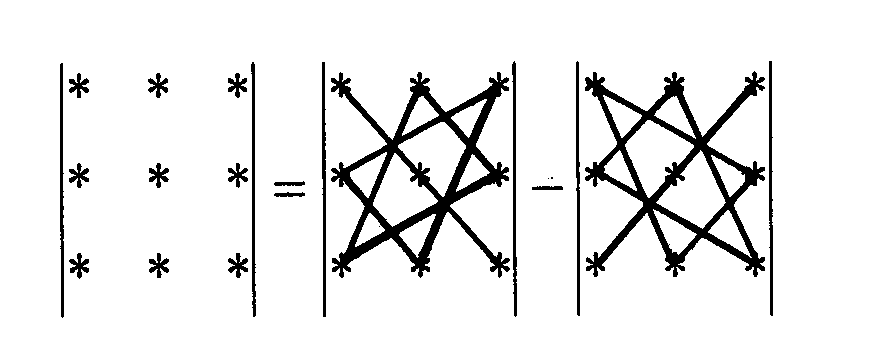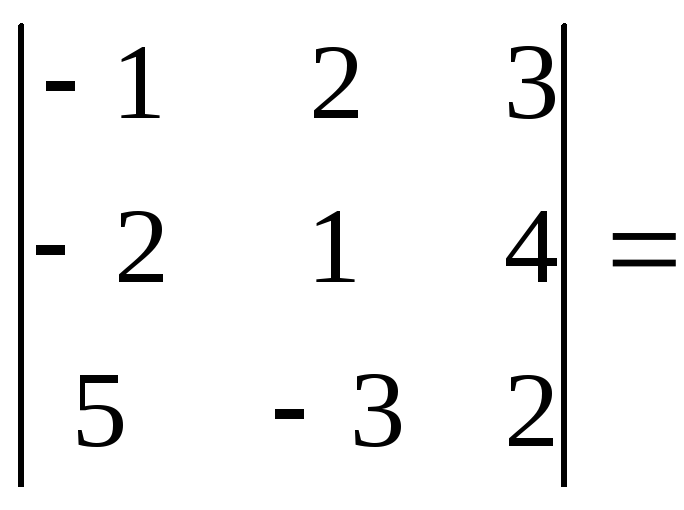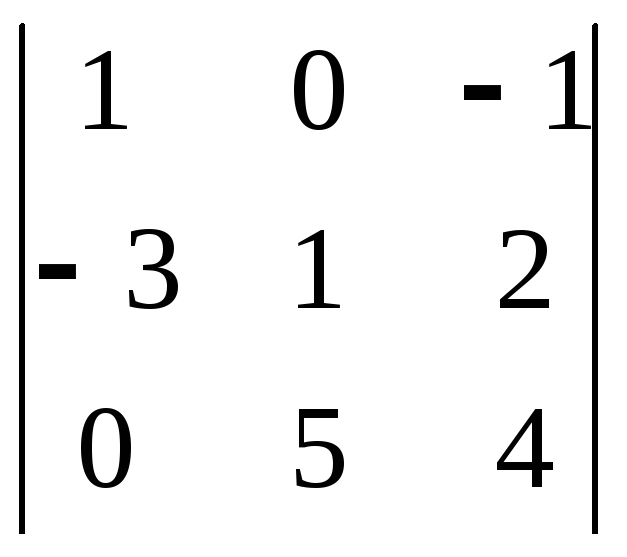
attachments / l2_alg_eng020114
.docLECTURE 2
Determinants, minors and cofactors.
Determinants of the second and third order.
The
determinant of the second order which
corresponds to a square matrix of the second order А(2;
2) =
 is the number denoted by the following symbol =
is the number denoted by the following symbol =![]() and which is equal to:
=
and which is equal to:
=
![]() (1)
(1)
This is illustrated by the following scheme:

Example:
=
![]() .
.
Observe that there is no determinant corresponding to a rectangular (non-square) matrix.
The
determinant of the third order
which corresponds to a square matrix of the third order
 is the number denoted by the following symbol
=
is the number denoted by the following symbol
=
 and which is equal to
and which is equal to
![]() (2)
(2)
For calculation of determinants of the third order is convenient to use «the triangle rule» which follows from the formula (2) and symbolically is written as:

or

Example:
 (–1)12
+ 245
+ (–2)(
–3)3
– 513
– (–2)22
– (–3)4(–1)
=
(–1)12
+ 245
+ (–2)(
–3)3
– 513
– (–2)22
– (–3)4(–1)
=
= –2 + 40 + 18 – 15 + 8 – 12 = 37.
Minors and cofactors (signed minors) of elements of a determinant.
The
minor
М![]() of the element a
of the element a![]() of
a square matrix A(n;
n)
is the determinant obtained from the given one by deleting both the
i-th
row and the j-th
column.
of
a square matrix A(n;
n)
is the determinant obtained from the given one by deleting both the
i-th
row and the j-th
column.
For
a determinant of the second order
=
![]() :
:
![]()
![]()
Example:
=![]()
![]()
![]()
![]()
For
a determinant of the third order = :
М
:
М![]() =
=![]() ;
;
M![]() =
=
![]() and etc.
and etc.
Example:
Find М![]() and М
and М![]() for the determinant of the third order
for the determinant of the third order
=
Solution:
М![]() =
=![]() =
0 + 5 = 5; М
=
0 + 5 = 5; М![]() =
=![]() =
16
0 = 16.
=
16
0 = 16.
The
cofactor
А![]() of the element а
of the element а![]() of a square matrix А(n;
n)
is the minor М
of a square matrix А(n;
n)
is the minor М![]() multiplied on the number (–1)
multiplied on the number (–1)![]() ,
i.e. А
,
i.e. А![]() =
(–1)
=
(–1)![]() М
М![]() .
.
Thus,
if the sum of indices i
+ j
of the element а![]() is even then the cofactor of this element coincides with its minor by
sign, i.e. А
is even then the cofactor of this element coincides with its minor by
sign, i.e. А![]() М
М![]() ;
if the sum of indices i
+ j
of the element а
;
if the sum of indices i
+ j
of the element а![]() is odd then the cofactor of this element is opposite to its minor by
sign, i.e. А
is odd then the cofactor of this element is opposite to its minor by
sign, i.e. А![]() =
– М
=
– М![]() .
.
Example:
Find А![]() and А
and А![]() for the determinant
=
for the determinant
=
![]()
Solution:
А![]() =
М
=
М![]() =
5;
А
=
5;
А![]() =
– М
=
– М![]() =
–
(–3) = 3.
=
–
(–3) = 3.
Example:
Find А![]() and А
and А![]() for the determinant
=
for the determinant
=

Solution:
А![]() = – М
= – М![]() =
= ![]() = – (10 – 0) = –10;
= – (10 – 0) = –10;
А![]() = М
= М![]() =
=
![]() = 20 + 3 = 23.
= 20 + 3 = 23.
Properties of determinants
(we consider them on examples)
Property 1. The value of a determinant doesn’t change if we replace all its rows by the corresponding columns and vice versa.
Example:
 =
=
 = 42.
= 42.
Property 2. If we replace any two neighbouring rows (columns) then the determinant will change a sign.
E

 xamples:
1)
xamples:
1)
 =
=  ,
,![]()



2)
![]()
 =
=  .
.
Corollary. A determinant having two identical rows (columns) is equal to zero.



E

 xamples:
xamples:
 = 0;
= 0;
 = 0.
= 0.
![]()
Property 3. If all the elements of a row (column) of a determinant are multiplied on the same non-zero number «m» then the determinant value increases (decreases) in «m» times.
Example:
![]() =
=
![]() = 7.
= 7.![]() For
example, multiply all the elements of the second column on 4. We
obtain:
For
example, multiply all the elements of the second column on 4. We
obtain:
![]()
Corollary 1. If all the elements of a row (column) of a determinant have a non-zero common multiplier, it can be taken out the determinant sign.
Example:
 (the common multiplier 2 was taken out from the last column).
(the common multiplier 2 was taken out from the last column).
Corollary 2. A determinant at which elements of two arbitrary rows (columns) are proportional respectively is equal to zero.
Example:
 (the elements of the first and the third columns are proportional
respectively, i.e.
(the elements of the first and the third columns are proportional
respectively, i.e. ).
).
Property 4. Let each element of an arbitrary row (column) be the sum of two addends. Then the determinant is equal to the sum of two determinants such that the corresponding row (column) of the first determinant consists of the first addends, and the corresponding row (column) of the second determinant consists of the second addends.
Example: For example, let the first column of the determinant be the sum of two addends. Then

Corollary. A determinant doesn’t change its value if all the elements of a row (column) are added to (subtracted from) the corresponding elements of an arbitrary other row (column) multiplied on the same non-zero number.
Example:
Compute the determinant by using its properties:

1)
Observe that the second column has the common multiplier 2. Take out
it for the determinant sign. We obtain:

2) If we add the second column to the first one, the obtained first column will have a common multiplier. Let’s do these two operations:

3) If we subtract the second row from the third one, the obtained third row will also have a common multiplier. Let’s do these two operations:

4) Observe that the first and the third rows of the determinant are identical. Consequently it is equal to zero.
Let's give statements of two theorems (without proof) permitting to calculate values of determinants of an arbitrary order by sequential reducing them to determinants of lower order.
Theorem 1. If all the elements of an arbitrary i–th row (either j–th column) of a determinant but aij are equal to zero, the determinant is equal to the product of this non-zero element aij on its cofactor Aij, i.e. = aij Aij.
Example: For example, let all the elements of the second column of the determinant but one are equal to zero. Then:

By using Theorem 1 we have reduced the determinant of the third order to a determinant of the second order.
Theorem 2. A determinant is equal to the sum of products of elements of an arbitrary row (column) on their cofactors. This operation is called a decomposition of a determinant on a row (column).
Example:
Compute the determinant of the fourth order

Solution: For example, decompose the determinant on elements of the second row (since it is the simplest). Then:

Theorem 2 allowed us to reduce the determinant order, i.e. to reduce the determinant of the fourth order to an algebraic sum of determinants of the third order.
Notion of a determinant of the n-th order
The determinant of the n–th order corresponding to a square matrix of the n–th order A(n; n) is the number which is equal to the sum of products of elements of an arbitrary row (column) on its cofactors, i.e.

or = a1j A1j + a2j A2j + … + aij Aij + … anj Anj.
Glossary
determinant – определитель, детерминант; decomposition – разложение
minor – минор; cofactor (signed minor) – алгебраическое дополнение
a triangle rule – правило треугольника; to coincide – совпадать
even – четный; odd – нечетный; neighbouring – соседний
Exercises for Seminar 2
2.1. Compute determinants of the second order:
a)
![]() b)
b)
![]()
2.2. Compute determinants of the third order:
a)
 b)
b)
 c)
c) d)
d)
2.3.
Find M11,
M23,
A31
and A12
if

2.4.
Compute the determinant of the fourth order:

2.5.
Solve the equation:
![]()
2.6.
Solve the inequality:
![]()
2.7. Compute the determinants by decomposing them on a row (a column) containing letters:
a)
 ;
b)
;
b)
 ;
c)
;
c)
 .
.
2.8. Compute the determinants:
a)
 ;
b)
;
b)
 ;
c)
;
c)
 .
.
2.9.
Prove that
 .
.
Exercises for Homework 2
2.10. Compute determinants of the second order:
a)
![]() b)
b)
![]()
2.11. Compute determinants of the third order:
a)
 b)
b)
 c)
c)
2.12.
Find M22,
M32,
A33
and A21
if

2.13.
Compute the determinant of the fourth order:

2.14.
Solve the equation:

2.15.
Solve the inequality:

2.16. Compute the determinants:
a)
 ;
b)
;
b)
 ;
c)
;
c)
 .
.
